 Humans
Humans  Humans
Humans  Animals
Animals 10 Ways Animals Use Deception to Survive
 Movies and TV
Movies and TV 10 Misdirections Directors Used to Manipulate Actors
 Politics
Politics The 10 Boldest Coup Attempts of the 21st Century
 Weird Stuff
Weird Stuff 10 Things That Would Have Killed You in the Old West
 Books
Books 10 Pen Names More Famous Than Their Authors
 Creepy
Creepy 10 Unnerving Legends from Around the World
 Movies and TV
Movies and TV 10 Amazing Lead Actor Ideas for Superhero Movies
 Our World
Our World 10 Crazy Facts about Cycads That Might Surprise You
 Technology
Technology 10 World-Changing Examples of Turning Dumb Technology into Smart Technology
 Humans
Humans 10 Inventors Who Died Awful Deaths in Their Own Creations
 Animals
Animals 10 Ways Animals Use Deception to Survive
 Movies and TV
Movies and TV 10 Misdirections Directors Used to Manipulate Actors
Who's Behind Listverse?

Jamie Frater
Head Editor
Jamie founded Listverse due to an insatiable desire to share fascinating, obscure, and bizarre facts. He has been a guest speaker on numerous national radio and television stations and is a five time published author.
More About Us Politics
Politics The 10 Boldest Coup Attempts of the 21st Century
 Weird Stuff
Weird Stuff 10 Things That Would Have Killed You in the Old West
 Books
Books 10 Pen Names More Famous Than Their Authors
 Creepy
Creepy 10 Unnerving Legends from Around the World
 Movies and TV
Movies and TV 10 Amazing Lead Actor Ideas for Superhero Movies
 Our World
Our World 10 Crazy Facts about Cycads That Might Surprise You
 Technology
Technology 10 World-Changing Examples of Turning Dumb Technology into Smart Technology
Top 10 Things That Prove Deserts Are Stranger Than You Think
Area 51 is not the only secret base in Nevada. Other deserts have ancient ships filled with treasure, vanishing monoliths and eternal songs.
10 A Huge Happy Cat
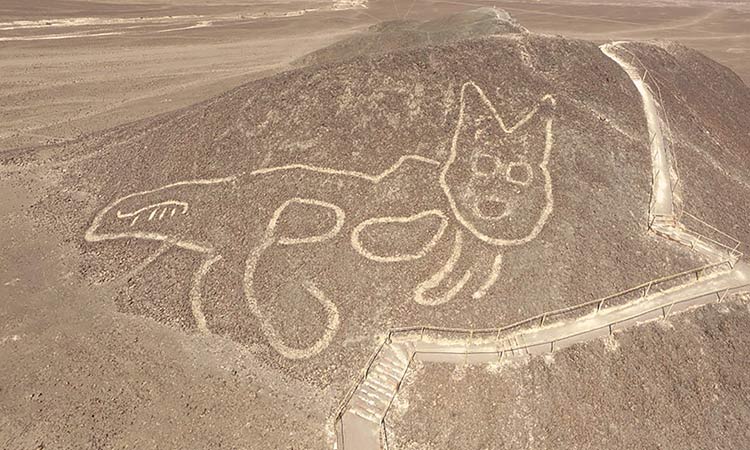
The Nazca Desert in Peru achieved infamy decades ago when massive geoglyphs were discovered on the ground. The ancient images include animals, birds, and geometric patterns. In 2020, a new geoglyph turned up. For cat lovers, the Cute Factor of the latest picture was a welcome change.
Etched into a cliff, the feline measures 37-meter (120-feet) long. The cat’s pose is relaxed and shows the animal resting on its back, almost as if begging for a belly scratch. The adorable theme is not the only thing that sets it apart from the other geoglyphs. Anyone who is familiar with the Nazca Lines will quickly notice that, compared to the others, the cat’s lines are more simple.
Age could explain why the cat does not have the complexity and straight lines that other Nazca art is known for. Clocking in at 2,000 years old, the kitty is the oldest geoglyph in the area. Perhaps, as one of the earliest attempts, the results were a bit wobbly. But as generations practised the unusual desert creations, they refined their skills and produced masterpieces that still defy our understanding.
9 Ice Filled With Life
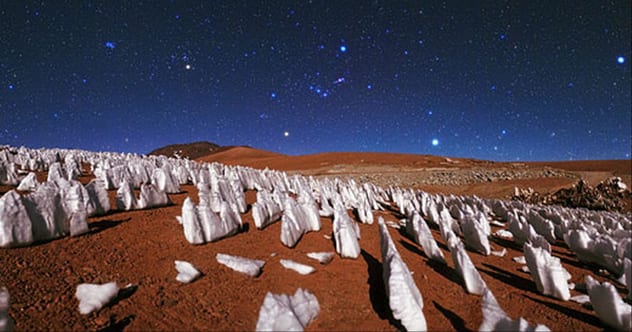
Ice is not supposed to grow in the desert. But under the right circumstances, like high altitudes and extremely dry land, fields of jagged ice spring up in deserts all over the world. Called “penitentes,” they look like upright blades that often grow as tall as a person.
In 2019, samples were removed from an ice field in Chile’s Atacama Desert. Some of the samples contained red patches. This was a stunning moment. In other parts of the world, red ice points to the presence of living microbes. This was something that had never been found inside penitentes before.
After a few tests, the microbes were identified as snow algae. They were related to species of algae that flourish inside alpine and polar ice. But how the organisms got inside the ice blades standing in the middle of the desert is a mystery.
8 An Endless Song (Sort Of)
In 1982, the band Toto produced their hit “Africa.” Almost 40 years later, somebody decided that the song should play in the desert. Forever. That someone was Max Siedentopf, a Namibian-German artist. As a rabid fan of the song, he had listened to “Africa” more than 400 times (by his own estimate).
Depending on one’s view, he created a piece of art or gave the desert a notorious earworm. But either way, he kept the location a secret. At his chosen spot, he placed several speakers and an MP3 player on white pedestals and hooked them up to a solar-powered battery system.
Somewhere in the Namid Desert, this song is playing on an endless loop. Well, that is the perfect scenario anyway. The artist never protected the installation from the harsh desert environment apart from using durable equipment. Siedentopf himself admitted that the desert would probably strangle the song sooner rather than later.
7 The Most Isolated Tree
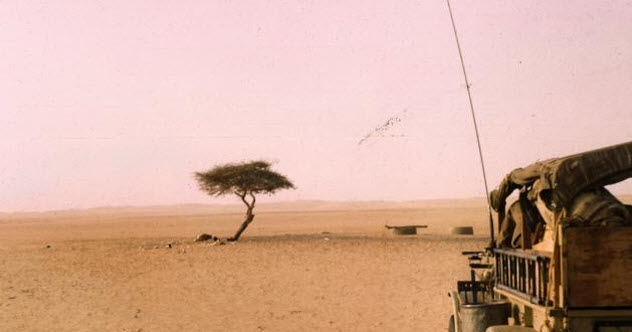
By the 1970s, the Tree of Tenere had stood in Niger’s Sahara desert for nearly 300 years. As the only tree around for 402 kilometres (250 miles), the acacia was used by ancient travellers as a landmark and it also featured on military maps from the 1930s.
The lonesome tree was born when the Sahara was greener and looked less like a desert. It died in 1973. The way the tree was killed infuriated many people. A drunk driver had been following an old caravan route when he ploughed into the Tree of Tenere.
The trunk of the tree is now displayed at the Niger National Museum. By way of remembrance, a metal monument was placed at the spot where the acacia had once stood.
6 1.8 Billion Trees
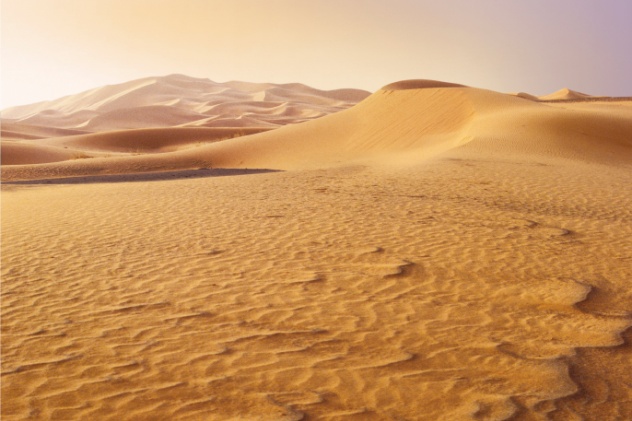
The Sahara desert had everyone fooled. From Joe on the ground to scientists, most people believed that the Sahara was nothing but ripples of sand and maybe a lizard. But nothing escapes the eye of artificial intelligence and satellites.
In 2020, a study used AI and NASA satellites to count trees in the desert. Incredibly, the project discovered more than 1.8 billion shrubs and trees hiding in the west of the Sahara. What makes the discovery so remarkable is the fact that they were inside a relatively small area. All told, the sneaky foliage covered an area of just 1.3 million square kilometres (501,933 square miles).
5 A Space Invader Called Witherspoon
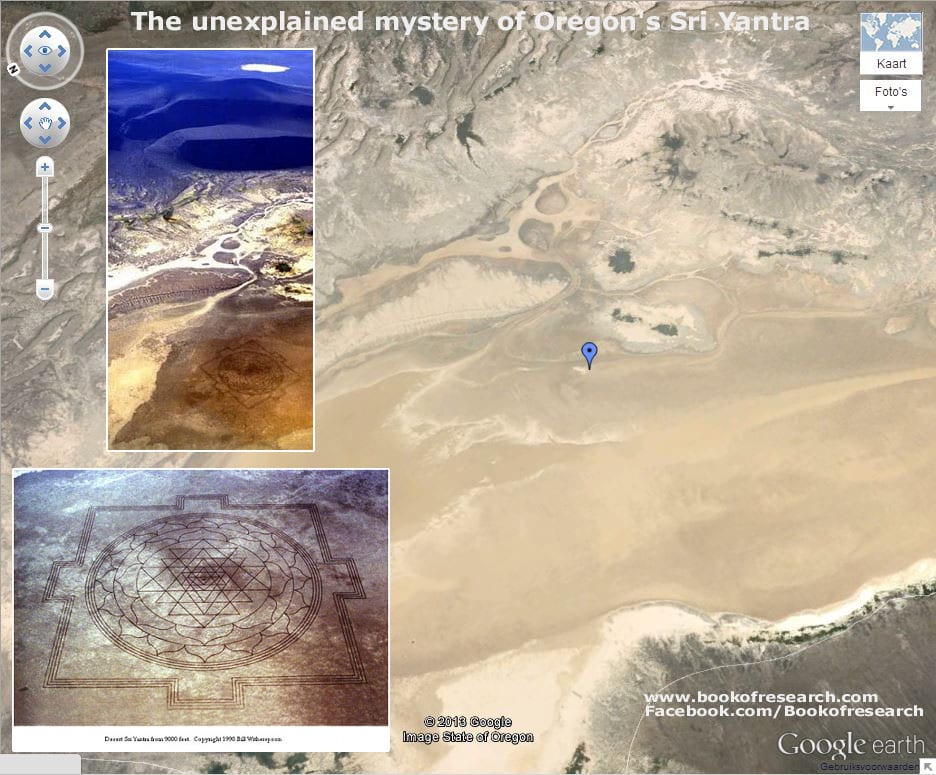
In 1990, pilots with the National Guard flew over the Alvord Desert in Oregon. At one point they looked down and saw something that would enthral the world. Down below, carved into the earth, was a massive symbol. It contained a square, circles, and petals. This arrangement was later identified as a Hindu symbol called Sri Yantra.
One of the most popular theories blamed aliens. But when the truth dawned, it involved a different kind of space invader. Indeed, when a man called Bill Witherspoon carved the image he never had permission to “decorate” what was a protected wilderness area.
Witherspoon refused to abandon his desert art. He promptly paid the $100 fine and then created more giant images (this time on a private ranch where he had permission). Not everyone was a fan of the carvings. Complaints ranged from environmental concerns to fears that Witherspoon was using the symbols to summon dark spirits.
4 A Place Called Slab City
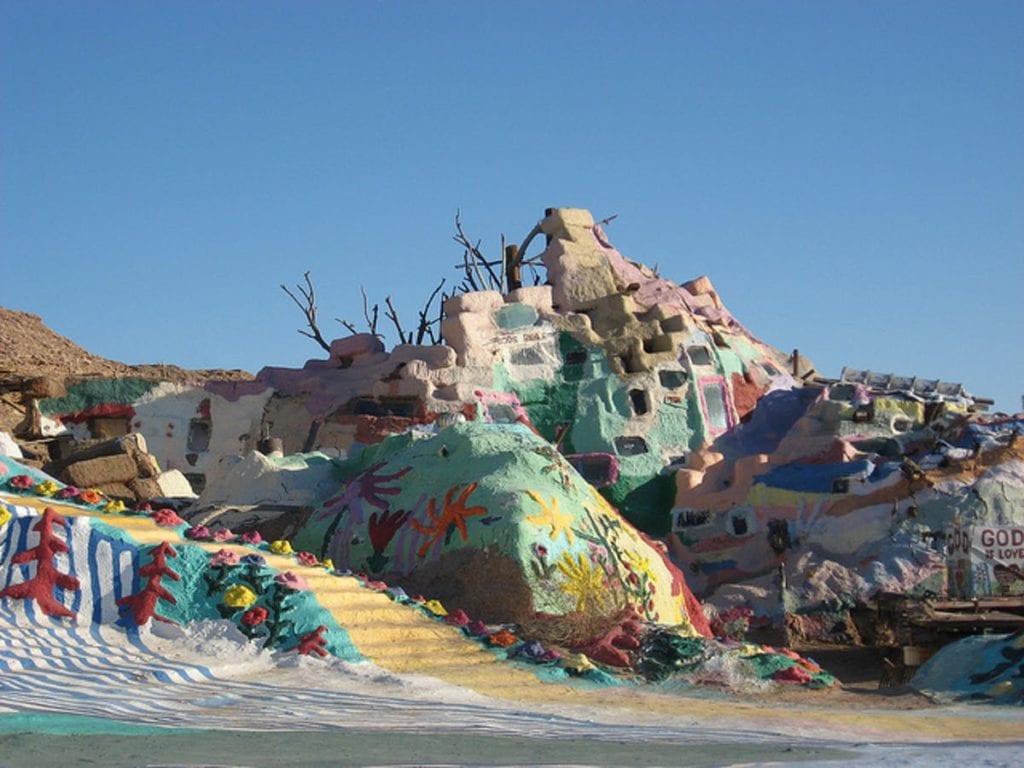
Camp Dunlap was a training base for Marines that was shut down after World War II. Squatters soon moved in and raised shacks on the concrete slabs of the base which also had a grid of streets. In no time, Slab City was born.
Located in California’s Colorado Desert, the inhabitants often portray themselves as the last free people in America. If freedom is based on taxes, then that may well be true. The taxman is not particularly interested in Slab City.
Other inhabitants include survivalists and adventurers. But those who arrive by choice is only one half of the story. Many families lose everything and have nowhere else to go except a squatter camp in the desert. Life is not easy. There is no running water, plumbing or hospitals. Did someone steal your wallet? Tough beans. The Slab City Police Department does not exist.
Slab City does not officially exist either.
3 The Utah Monolith
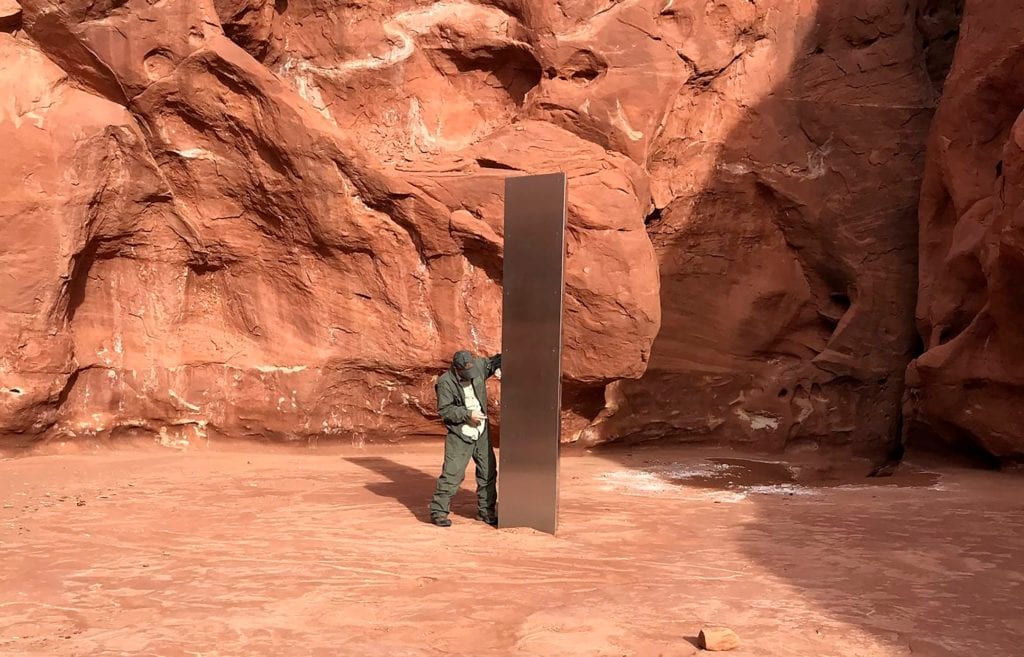
In 2020, wildlife officials flew over a remote part of Utah. The helicopter’s mission was to find and count bighorn sheep. Instead, the crew noticed something shiny down below. Intrigued by the reflective object, the helicopter landed nearby. What they found was a bizarre metal rectangle standing upright in a ravine.
This was no ancient artefact. But besides being new, what made the whole thing so odd was that someone had made the effort to plant the 3-meter (10-feet) pillar in bedrock, in the middle of nowhere, for seemingly no reason.
Fearing that sightseers would trample ancient sites or get lost in the desert, authorities kept the location a secret. But somebody found it. Roughly a week after the monolith was discovered, it disappeared.
2 A Ship Filled With Gold

In 1533, a ship called the Bom Jesus set sail from Portugal and vanished. Besides the loss of her entire crew, the ship also disappeared with a cargo of gold coins which, by today’s standards, was worth $12.5 million.
Nearly 500 years later, in 2016, miners stumbled upon the remains of the shipwreck. It was inside a dry lagoon in the Namibian desert. They alerted archaeologists who confirmed the identity of the vessel. After six days of excavations, the gold was recovered.
Media outlets lost their minds over the precious coins. But the archaeologists? They were more excited about the human bones, clothing, and pottery that were also discovered. Almost nothing is known about the daily lives of sailors who lived centuries ago. Since such artefacts can tell us more, they are, in a historical sense, more valuable than gold.
1 Area 6
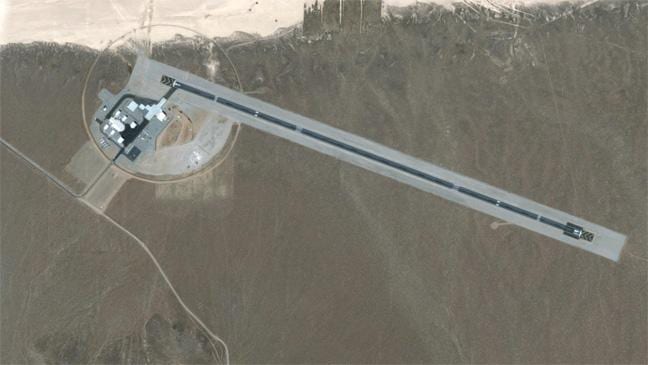
Area 51 needs no introduction. But the base is not the only secretive zone in the Nevada desert. Meet Area 6; a smaller complex with hangars and a 1.6 kilometre (1 mile) long landing strip.
Airspace is restricted and the entire place is fenced off. About 19 kilometres (12 miles) separate Area 6 from Area 51 and the airstrip is used by both Homeland Security and the Department of Defense. Beyond that, the facts get hazy.
When the departments were pressed for answers, an official spokesperson admitted to a short clue, saying that “They come here to test their own sensors.” Investigators also found the license application of the contractor who had built the airstrip. The paperwork described the facility as a place where unmanned vehicles are created and tested.
Based on that, some have suggested that Area 6 holds MQ-9 Reaper planes. These are drones that specialize in reconnaissance missions. Area 6 could be where new technology related to the planes are tested and the surrounding landscape is also perfect for dry runs of actual missions.
10 Hidden Secrets Of The Sahara Desert








